REGIMENTING TOMATOES
/16 Comments/in Pruning, Vegetables/by Lee ReichWhat’s Better: Loosy Goosy or Soldier Straight?
I wonder how much our gardens reflect our personalities? Some gardeners clip their yew bushes “plumb and square;” other gardeners clip or shear away at their plants more haphazardly. Even in the vegetable patch, a temperament may be reflected in the way tomatoes are grown: Do the plants sprawl over the ground with abandon, are they contained within strings woven up and down the row, or are they neatly staked? (Woven tomatoes or those grown in wire cages are more or less sprawling plants, held aloft.)
Whatever your temperament, a good case can be made for staking tomatoes. Tomatoes on a staked plant are larger and ripen earlier than those on a sprawling plant. Good air circulation around leaves and fruits of upright plants lessens disease problems. And fruits held high above the ground also are free from dirt and slug bites. You’ll harvest less fruit from each staked plant, but since staking makes best use of the third dimension, up, staked plants can be set as close as eighteen inches apart. So staking gives the best yields per square foot — especially important in small gardens.
Flavor Picks
Tomato varieties suitable for staking are so-called “indeterminate” types, which form fruit clusters at intervals along their ever-elongating stems. “Determinate” varieties, in contrast, bearsfruits at the ends of their branches, so if a plant was pruned for staking would be reduced to a single short stem capped by a single cluster of fruits. Seed catalogues and packets usually indicate which varieties are suitable for staking.
Determinate varieties are bushy plants that need little regimenting. They also ripen their fruits within a shorter window of time.
So what’s not to like about determinate varieties? Flavor! With fewer leaves per fruit than indeterminate varieties, flavor suffers. That concentrated ripening period also can stress the plants, making them more prone to disease.
As you might guess, I grow only indeterminate varieties of tomatoes. Flavor is my main criterion in selecting a variety to grow.
Staking
When choosing a suitable stake for staking (indeterminate, of course) tomato plants, don’t be misled by the puniness of tomato transplants. A tomato stake needs to be be six to eight feet long and metal or at least one by two inches thick if made of wood. I use EMT (electrical metallic tubing) conduit, 5/8 inch diameter and 10 feet long, cut down to 7 feet. It’s easy to pound into the ground (okay, I’ll admit that here on the floodplain there are no rocks), easy to remove, and reusable for years and years.
Most books and other sources of information suggest “planting” your stake along with your tomato plant to avoid root damage later on. Not true. My established tomato plants never bat an eyelash (figuratively speaking) as I pound in metal stakes only a couple of inches from their stems. And there’s a good reason to wait until the plants are well-established; by then, chance of cold damage is reliably history. Early planted stakes would interfere with my trying to throw a protective blanket over a row of staked tomatoes should cold threaten.
With the base of a stake set a couple of inches from a plant and a 3 foot length of iron pipe, capped at one end and slid over the conduit’s free end, the stake pounds in easily with repeated lifting and forcefully lowering.
Indeterminate tomatoes are vines, but not vines that can climb by themselves. So they need to be tied to their stakes. Material for ties should be strong enough to hold the plants the whole season, and bulky enough so as not to cut into plants’ stems. Coarse twine or cotton rags, torn into strips, are good materials. I use sisal binder twine.
The usual recommendation, when tying, is to first tie a knot around the stake tightly enough to prevent downward slipping, then use the free ends of the rag strip or twine to tie a loose loop around the plant’s stem. False! With every foot or so of growth, I tie a single loop loosely around stem and stake above a node; the string can’t slip down lower than the node.
Pruning
Now for the pruning: Confine each plant to a single stem by removing all suckers, ideally before any are an inch long. A sucker is a shoot that grows from a bud originating at the juncture of a leaf and the main stem.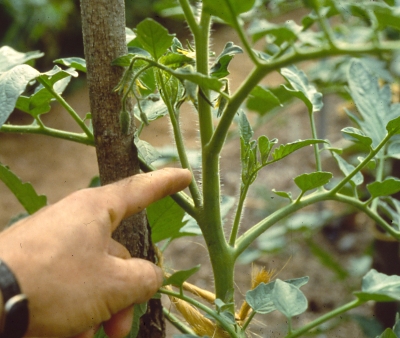
Go over your plants at least weekly, using your fingers to snap off each side shoot. (Cutting the shoots with a knife or pruning shear may transmit disease between plants as a blade touches cut surfaces.) Occasionally step back and refocus your eyes on the plant as a whole; I find that I sometimes overlook a sucker that has snuck up with two feet of growth I missed as I focussed on still small shoots just appearing from buds.
One final bit of pruning that some gardeners practice is to pinch out the growing tip of the plant when the stem reaches the top of the stake, then continue to remove any new leaves or flowers that form. This is a little chancy, since the effect depends on the maturity of a plant’s leaves and fruits. At worst, you reduce yield to a few clusters of fruit. But at best, your tomatoes are even earlier and larger. It may be worth a try on a couple of plants.
How do your tomatoes grow, up or sprawling. A case can be made for “up.” But you need the right variety, stake, and method of pruning.
Upcoming GROWING FIGS IN COLD CLIMATES webinar
/4 Comments/in Fruit/by Lee Reich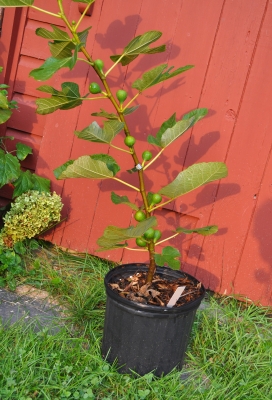 Last reminder for GROWING FIGS IN COLD CLIMATES webinar.
Last reminder for GROWING FIGS IN COLD CLIMATES webinar.
Monday, June 6, 2022, 7-9 pm Eastern Time
Cost: $35
Registration is necessary; register and pay (credit card or Paypal) at:
https://us02web.zoom.us/webinar/register/WN_4hqKduDNSyiuRGPBlmBObg
Contact me if you prefer to pay by check.
Learn what makes this subtropical plant so adaptable that you can harvest fresh fruit from it even in cold climates, and practical applications of this information. I’ll cover a few of the methods for being on your way to fig-dom, including winter care, pruning, varieties, and speeding up ripening. There’ll be plenty of time for questions.

San Piero fig, ripe
NO MO’ NO MOW MAY(?)
/14 Comments/in Design/by Lee ReichWhat and Why?
The Month of May has ended, as has “No Mow May.” If you’ve never heard of “No Mow May,” it’s the rallying cry of a movement that began in the UK, suggesting that all of us who nurture greenswards abandon our efforts for the month of May. In so doing, habitat and food, in the form of early blooming wildflowers such as dandelions, clover, creeping Charlie, and violets, would become more available to early season pollinating insects.
Let’s dive deeper into what “No Mow May” accomplishes, whether this movement has any drawbacks, and, finally, possible alternatives.
A lawn is typically a monoculture, or nearly so. Not mowing during this month when heat and rainfall spur rapid plant growth encourages more diversity, which makes environments more resilient.
Gasoline-powered mowers spew out great quantities of carbon dioxide and pollutants. Over the course of a year, one such machine pollutes the same amount as 43 new cars, each driven 12,000 miles! And all that noise. Not to also mention toxic pollutants entering the environment (13 billion pounds per year from lawns) and our collective lawns thirst for copious amount of water.
“No Mow May” puts a hold on all these environmental affronts, at least for the month.
Does It Fill The Bill?
Take a closer look at what this deliberate neglect has fostered. Peer at a no mow lawn, perhaps yours, and you’ll see some of the aforementioned wildflowers. Wait, though. Plants such as dandelion and creeping Charlie, are not native. 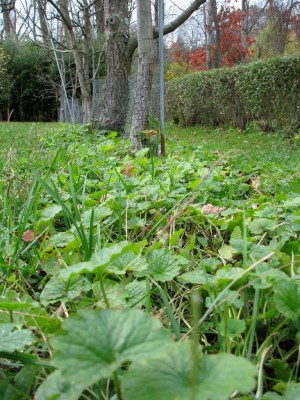 And dandelion, for one, can negatively impact animals and even other plants. Its pollen is nutritionally poor for bees, low in valine, isoleucine, leucine and arginine, all essential amino acids for honey bees. Problem is that bees can become faithful to one plant, so might fail to sufficiently pollinate other plants or ignore more nutritious pollen sources if they get started on dandelions. And dandelion’s allelopathic pollen inhibits seed development of some other plants.
And dandelion, for one, can negatively impact animals and even other plants. Its pollen is nutritionally poor for bees, low in valine, isoleucine, leucine and arginine, all essential amino acids for honey bees. Problem is that bees can become faithful to one plant, so might fail to sufficiently pollinate other plants or ignore more nutritious pollen sources if they get started on dandelions. And dandelion’s allelopathic pollen inhibits seed development of some other plants.
Leaving the mower parked in the garage or barn for May will, of course, change the appearance of your lawn, a look that has been part of our collective aesthetic from the past. Local ordinances might even prohibit “No Mow May.”
Despite certain drawbacks, mown lawn is functional, providing a soft, inviting surface for lounging, for playing, for picnicking, and other civilized activities.

Manet’s “Luncheon on the Grass”
Tall grass is not nearly so inviting, especially as mice and other rodents feel more secure from predators scampering beneath the cover of long grass. Ticks enjoy such habitat, and are carried around by the mice, increasing threat of Lyme disease and other tick-borne illnesses.
Okay, so it’s the end of the month and you’re ready to mow. It’s not going to be easy to plow through all that vegetation. And all those clumps of grass clippings? You’ll probably have to rake them up so the lawn doesn’t get smothered.
The grass itself isn’t going to fair well with the drastic end-of-the-month pruning. Grasses are healthiest if blades are cut back by no more than one-third their length. So two mowings may be in order to bring grass down to mown height. If you wait a few days between mowings , then clippings from the first cut have time to dry out, so you may be able to forgo having to rake them up.
When all is said and done, does one month of not mowing an established lawn really encourage a burst of wildflowers or other biological changes? Probably not. The “No Mow May” lawns that I see look mostly just like unmown grass.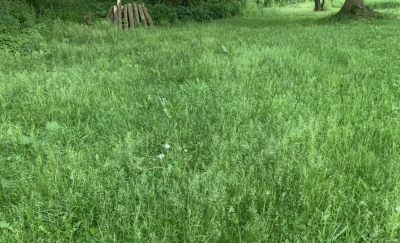
Alternatives
Probably the easiest way to get the best of both worlds, or at least some of both worlds, would be with “One Mow May” or “Less Mow May” rather than “No Mow May.”
Or, replace part of the lawn with a garden, perhaps a wildflower garden, or even just areas with groundcovers rather than lawn.
My top alternative to “No Mow May” is what I’ve called Lawn Nouveau, an idea I had years ago that reflected my lack of time and enthusiasm for mowing the lawn. Here’s an adaptation of Lawn Nouveau, as I described it in the mowing chapter — yes, mowing is a type of pruning — of my book The Pruning Book (available here, signed, or from the usual sources):
The low grass is just like any other lawn, and kept that way with a lawnmower. Other portions are allowed to grow, and are mowed infrequently –- one to three times a year, depending on the desired look. Mowings from the tall grass portions must be raked up after mowing or else they’d leave unsightly clumps and smother regrowth, but they are good material for mulch or compost.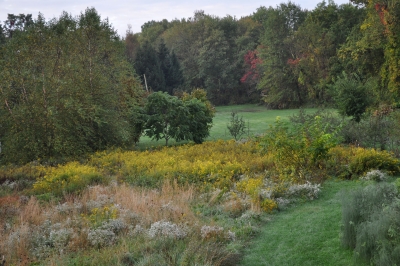
A crisp boundary between tall and low grass keeps everything neat and avoids the appearance of an unmown lawn. Tall and short grass can help define areas. Rather than straight edges and 90° corners, curves in bold sweeps can carry you along, then pull you forward and push you backward, as you look upon them. Avenues of low grass cut into the tall grass invite exploration, and, like the broad sweeps, can be altered throughout the season.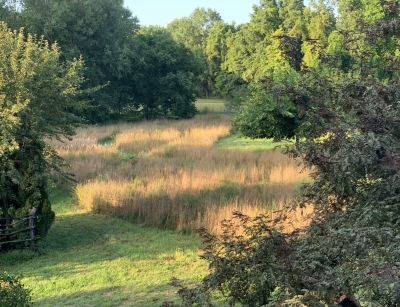
The “tall grass” becomes more than just grass as other plant species gradually elbow their way in. Which ones gain foothold depends on the weather and frequency of mowing. 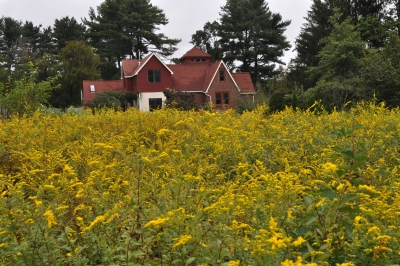 An attractive mix of Queen Anne’s lace, goldenrod, chicory, and red clover might mingle with the grasses in a dry, sunny area, with ferns, sedges, and buttercups mixing with the grasses in a wetter portion.
An attractive mix of Queen Anne’s lace, goldenrod, chicory, and red clover might mingle with the grasses in a dry, sunny area, with ferns, sedges, and buttercups mixing with the grasses in a wetter portion.
I now have a one-and-a half acre meadow which, along with some lawn around my home, constitutes Lawn Nouveau here. No need for large property, though; my original property was 3/4 acre, and that’s where Lawn Nouveau began way back when.
In Praise of the (Austrian) Scythe
My preferred implement for mowing the tall grass is a scythe. Not the so-called American type scythe, with a curved handle and stamped blade, which is put to best use decorating the wall of a barn. I use a so-called Austrian type scythe (purchased from www.scythesupply.com), which usually has a straight handle and is lightweight with a razor sharp, hammered-thin blade.
Much of my one acre meadow gets a once-a-year mowing with my tractor, but you’ll still find me out there early summer mornings with my scythe. 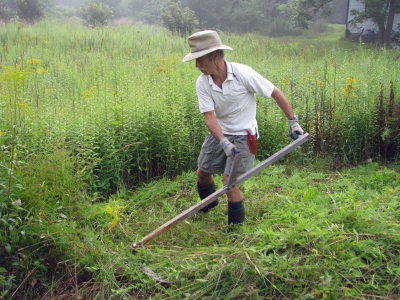 It’s a joy to step out in the dewy coolness and swing my scythe, the only sounds being that of birds singing and the scythe blade whooshing through the turgid, green stalks of meadow plants.
It’s a joy to step out in the dewy coolness and swing my scythe, the only sounds being that of birds singing and the scythe blade whooshing through the turgid, green stalks of meadow plants.
(For a short scything video, see https://leereich.com/video.)

